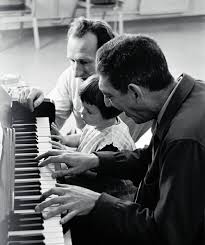Paul Nordoff believed that the diminished 7th is one of the most important chords in music (Nordoff & Robbins, 1998). The diminished 7th brings with it so many harmonic possibilities. Therefore it is a tremendous asset for the music therapist to have at finger tips when engaging clients in musical experiences. . This post will discuss two functions of the diminished 7th chord: 1) as a passing chord and 2) as a pivot or modulating chord (functioning as a Dominant 7th chord).
Diminished 7th as a Chromatic Passing Chord
Using the Dim 7th as a passing chord can help guide a melody, creating a bridge to the subsequent chord. This bridge can create tension, setting up the resolution for the following chord. This structure between tension and resolution is what helps the music move, breathe, fluctuate, anticipate, and provide meaning for what is about to happen. Depending how long you sustain the tension and delay resolution can alter “musical-time” and provides the clinician with a way to alter the future based on the client’s interaction. Here’s a simple example of the Dim 7th being used as a passing chord:
Diminished 7th chord being used as a passing chord
Exercise examples:
- IM–> I#°7 IIm7- V7à I
- IM–> I#°7à IIm7- II#°7- I- V7- I
- IM–> I#°7 IIm7- II#°7- IIIm6- IV°7- V7- I
Functioning as a V7 Substitution
The diminished seventh chord is often used in place of a dominant 7th chord. In the key of C Major the V chord, G dominant 7th (which is made up the notes G,B,D,F) can be replaced with a G# diminished seventh chord (G#, B, D, F). In order to create chromatic movement, you can play a B diminished 7th (B,D,F,G#)chord or an inverted G# diminished
What’s important to note is that any note in the diminished 7th chord can be the root. A simple tip to remember, when using this chord as a V7 substitution, take the root note from the V7 chord (in the key of C would be G) and raise it a half step, while keeping the other notes (G#,B,D,F). You’ll notice how similar the G7 chord (G,B,D,F) is to G# diminished (G#,B,D,F). To take this a step further, because: any note in the diminished can be the root, which means that we can modulate to several different keys.
The Dim 7th as a dominant chord provides the therapist with endless possibilities in regards to totality, harmony, as well as dictate melodic development and movement. In addition, I bring back the idea of tension and resolution (because, let’s face it, within tension we can never have resolution and without resolution we can never have tension. Thus, without either, I’m not sure what we would have!) Here, we can maintain the dominant vibe or function and sustain that feeling of holding (and tension) while moving from one Dim 7th inversion to the next.
Example: Let’s look at G# diminished 7: G#,B,D,F
- If you flat the G# – G you have a G7 CM, Cm, AM, or Am
- If you flat the B – Bb you have Bb7 EbM, Ebm, CM, or Cm
- If you flat the D -Db you have Db7 GbM, Gbm, EbM, or Ebm
- If you flat the F -Fb you have Fb7(E7) AM, Am, F#M, or F#m
Example: Essentially what this means is that if played a G# diminished 7th chord, you are also playing B, D, and F diminished, which in turn means that you resolve to any of the following:
- CM, Cm, AM, or Am
- EbM, Ebm, CM, or Cm
- GbM, Gbm, EbM, or Ebm
- AM, Am, F#M, or F#m
These examples are only a fraction of the musical and musical-clinical possibilities. I hope that this can be the start or a refresher to how we think about and play music!
If you like this post please share and/or subscribe to this blog!
Musically,
John
Reference
Nordoff, P. & Robbins, C ( 1998 ). Paul Nordoff Exploring the Tonal Language of Music. Gilsum, NH: Barcelona Publishers

